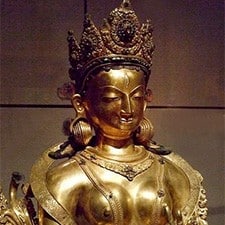Who is White Tara?
This talk was given during the White Tara Winter Retreat at Sravasti Abbey.
- All buddhas have realizations; you can’t differentiate them
- The different forms buddhas appear in represent different aspects of the omniscient mind
- The different things that Tara’s aspect represent
White Tara Retreat 01: Who is White Tara? (download)
Today, we will start the talks for the new retreat from afar, and I thought what to do is to talk about White Tara; to make it a series. Then, we will go through the sadhana and talk about different parts of the sadhana, because that will help everybody who is doing the retreat from afar and everybody who is doing the retreat here.
Who is White Tara?
Let us talk a little bit about White Tara to start with. All the buddhas have the same realizations; you can’t differentiate them. From the side of a Buddha, they don’t have the same feeling of “I” that we deluded beings do. The minds of all the buddhas know the same thing; they have the same realizations and so on. Because we can’t communicate with the Buddha’s mind directly, the buddhas appear in different physical forms and the physical forms represent certain aspects of a Buddha’s omniscient mind.
Enlightened activity
Tara’s aspect—there are a few different things it represents. One is that she represents the enlightened activity of the Buddha, the trinley of the Buddha. That is the way in which the buddhas interact with sentient beings to help ripen our mind. Tara represents that kind of activity of interacting with sentient beings to help ripen their minds. This is one way to think of Tara.
Quick wisdom
Lama Yeshe used to say, “Women have quick wisdom.” Tara represents also wisdom, but quick wisdom; it is not deluded wisdom. Actually, wisdom can’t be deluded; that’s an oxymoron. You know how sometimes we think we’re acting from a space of wisdom, but it’s actually a space of ignorance? Have you ever done that? Like: “I know this is the right thing to do. My motivation is good and I’m acting completely right,” and then, we find out later our mind was completely under the influence of ridiculous ways of thinking—that we thought were wisdom at the moment. Tara’s quick wisdom is not that; Tara’s quick wisdom is actual wisdom.
Long life
Also, she represents a long life, and the ability to extend our lifetime not simply because we don’t want to die. We’ve died infinite times in previous lives; we don’t need to be afraid of it. We need to be concerned with what happens after death: where we are reborn. Dying? We’ve lived through it many times. When you think about it, we’ve died infinite times in samsara. We’ve lived through it! To extend our lifespan so we have more time to practice the Dharma—that is the purpose of it. If we don’t practice the Dharma, then it really doesn’t matter whether we have a long life or a short life. However, if we practice the Dharma, then having a long life is very, very useful.
Those were the specialties of Tara; a way to relate to her.
Purification and restoration
Also, the white color of her body usually represents cleansing. We can think, especially in the visualization—it is very much a purification visualization. We’re purifying things that could shorten our lifespan: things such as degeneration of the elements of the body, or the life force being stolen, or broken ethical restraints, broken precepts, broken commitments.
You’ll remember, in initiation, that we invoke Tara’s blessings in the form of her implements, small deities, the mantra, and the letters om ah hum. Rinpoche said that that represented restoring the energy of our broken commitments and ethical restraints. Those broken precepts can degenerate our lifespan, so we want to restore them. We invoke all of that energy, and this beautiful white energy from Tara is coming down into us, purifying everything that needs to be purified, including negative karma. This is also restoring the lifespan, any kind of rebalancing the elements in our body, or restoring any lost energy of any of the elements in our body, and also restoring the vows, our ethical restraints, and our commitments. That is just one way to think about Tara to start with.
Venerable Thubten Chodron
Venerable Chodron emphasizes the practical application of Buddha’s teachings in our daily lives and is especially skilled at explaining them in ways easily understood and practiced by Westerners. She is well known for her warm, humorous, and lucid teachings. She was ordained as a Buddhist nun in 1977 by Kyabje Ling Rinpoche in Dharamsala, India, and in 1986 she received bhikshuni (full) ordination in Taiwan. Read her full bio.


